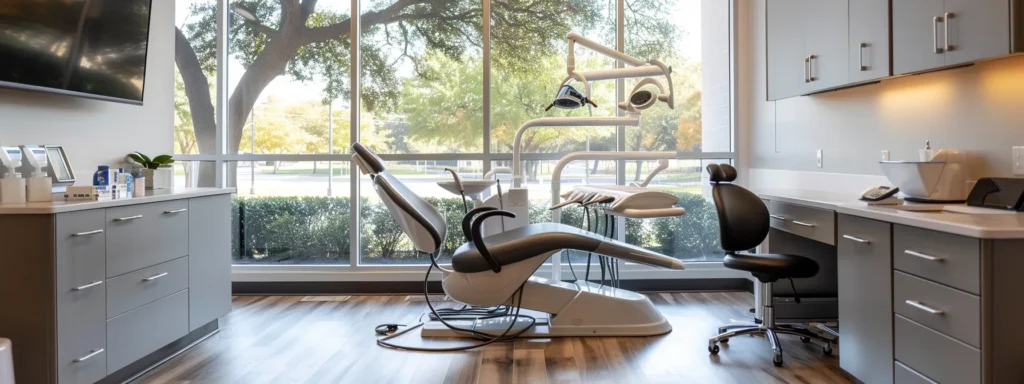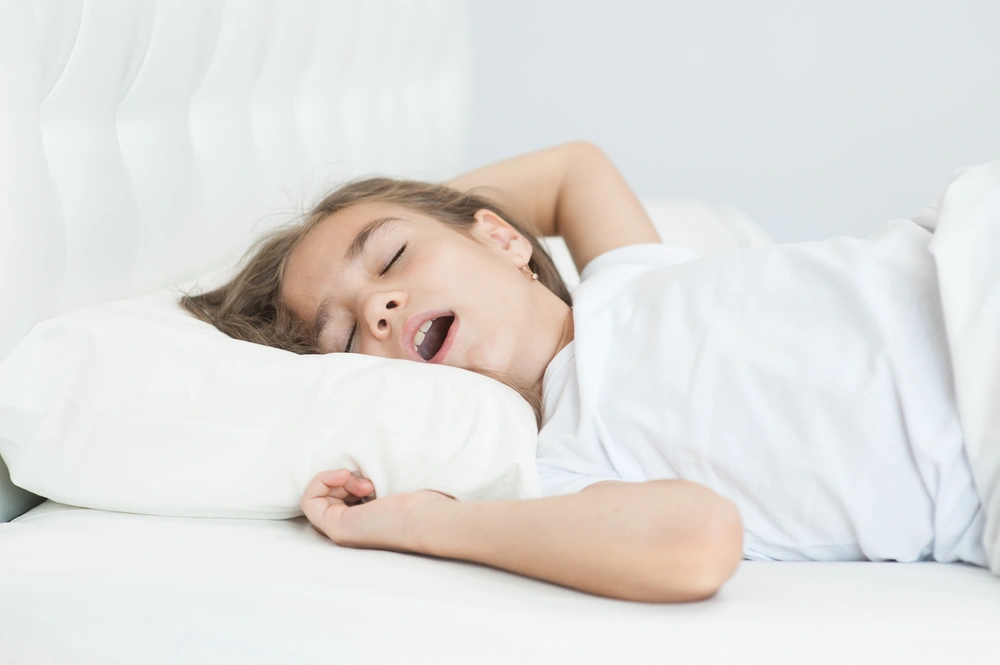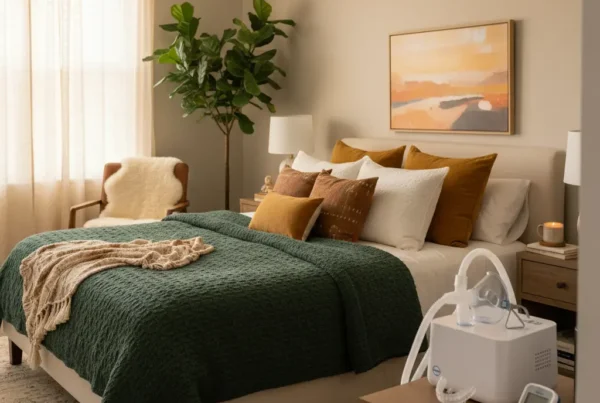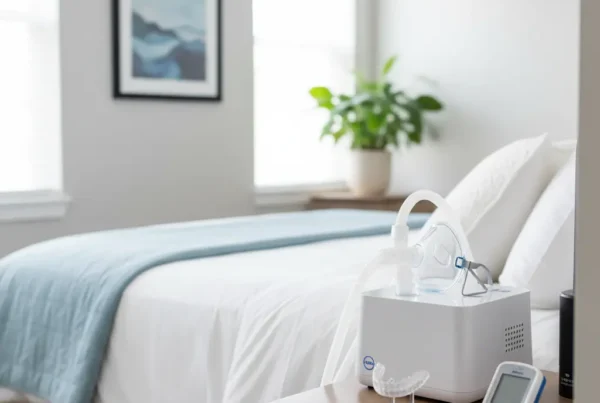Sleep position dramatically affects obstructive sleep apnea severity, with back sleeping often worsening symptoms due to gravity’s effect on airway collapse. Dr. Chris Cappetta’s 35+ years of experience in dental sleep medicine helps patients understand how simple positional changes can significantly reduce apnea episodes and improve sleep quality naturally.
How Sleep Position Affects Your Breathing
Sleep position plays a crucial role in obstructive sleep apnea severity. When you sleep on your back, gravity pulls your tongue and soft tissues backward toward your throat. This natural gravitational effect can partially or completely block your airway during sleep.
Dr. Chris Cappetta, with over three decades of experience in dental sleep medicine, understands how anatomical factors influence sleep-disordered breathing. His expertise as an ADA member and Academy of General Dentistry affiliate helps patients grasp the connection between position and breathing quality. Understanding your unique airway anatomy is fundamental to managing OSA effectively.
Many patients don’t realize how dramatically their sleep position impacts their symptoms. The supine position often doubles or triples the number of apnea episodes compared to side sleeping. This positional dependency affects nearly 65% of sleep apnea patients to varying degrees.
Our San Antonio clinic integrates personalized demonstrations to show patients exactly how different positions affect their breathing. This hands-on approach helps you understand the tangible benefits of positional changes on sleep quality. Seeing these effects firsthand makes the connection between position and symptoms crystal clear.
Identifying Position-Dependent Sleep Apnea
Not everyone with sleep apnea experiences positional dependency. Identifying whether your symptoms worsen in specific positions requires careful evaluation and understanding of your sleep patterns. Position-dependent sleep apnea typically shows dramatic differences between back and side sleeping events.
Sleep study results reveal the true extent of positional influence on your condition. Apnea-hypopnea index scores often show stark contrasts between supine and lateral sleeping positions. Patients with position-dependent OSA might have severe symptoms while back sleeping but minimal events when side sleeping.
Key indicators of positional sleep apnea include:
- Significantly more apnea events when sleeping on your back
- Partner reports of louder snoring in certain positions
- Better sleep quality when avoiding back sleeping
- Waking up more refreshed after side sleeping
- Fewer morning headaches with position changes
Understanding these patterns helps determine if positional therapy could be beneficial for your specific situation. Dr. Cappetta’s extensive knowledge in sleep medicine helps patients recognize these important distinctions. This awareness forms the foundation for developing effective treatment strategies.
Simple Positional Therapy Techniques
Positional therapy doesn’t require expensive equipment or complex procedures. Simple techniques can effectively encourage side sleeping throughout the night. The classic “tennis ball technique” involves sewing a tennis ball into the back of your pajama top.
Modern approaches offer more comfortable alternatives to traditional methods. Specialized positional devices provide gentle vibration when you roll onto your back. These smart devices learn your sleep patterns and encourage position changes without fully waking you.
Pillow arrangements can naturally promote side sleeping positions. Body pillows, wedge pillows, and specially designed sleep positioning aids help maintain lateral sleeping throughout the night. These tools work by making back sleeping uncomfortable or physically difficult.
Sleep hygiene modifications support positional therapy effectiveness. Maintaining consistent bedtime routines, optimizing bedroom temperature, and creating comfortable side sleeping environments all contribute to success. Our San Antonio team provides comprehensive guidance on implementing these changes effectively.
Combining Positional Therapy with Other Treatments
Positional therapy works well as a standalone treatment for some patients. However, many people benefit from combining it with other sleep apnea management approaches. This integrated strategy addresses multiple factors contributing to airway obstruction during sleep.
Weight management enhances positional therapy effectiveness significantly. Even modest weight loss reduces tissue pressure around the airway. Combined with proper sleep positioning, weight management can dramatically improve symptoms for many patients.
Oral appliances complement positional therapy by mechanically maintaining airway patency. While position prevents gravitational airway collapse, oral devices provide structural support. Dr. Cappetta’s expertise in dental sleep medicine helps patients understand how these treatments work together.
Complementary treatments that enhance positional therapy include:
- Custom oral appliances for airway support
- Weight management programs for tissue reduction
- Sleep hygiene improvements for better rest quality
- Nasal breathing optimization techniques
- Stress management for muscle relaxation
Lifestyle modifications support all sleep apnea treatments effectively. Avoiding alcohol before bedtime prevents muscle relaxation that contributes to airway collapse. Regular exercise improves overall sleep quality and supports healthy weight maintenance.
Evaluating Treatment Success
Success with positional therapy depends on consistent implementation and objective monitoring. Many patients notice improvements within days of making positional changes. However, long-term success requires sustained commitment to new sleep habits.
Sleep quality indicators help assess positional therapy effectiveness. Reduced daytime sleepiness, improved morning alertness, and decreased snoring often signal successful treatment. Partners frequently report better sleep quality when positional therapy reduces disruptive snoring and breathing interruptions.
Objective measurements provide the most accurate assessment of treatment success. Follow-up sleep studies can quantify improvements in apnea events and oxygen levels. Home sleep testing offers convenient monitoring options for tracking positional therapy benefits.
Dr. Cappetta’s experience helps patients recognize subtle improvements that indicate successful treatment. Better cognitive function, improved mood, and increased energy levels often accompany reduced apnea episodes. These quality of life improvements demonstrate the comprehensive benefits of effective sleep apnea management.

When to Consider Additional Treatments
Positional therapy alone may not be sufficient for severe sleep apnea cases. Understanding when additional treatments are necessary prevents undertreated sleep apnea from affecting your health. Clear guidelines help determine when therapy escalation is appropriate.
Persistent daytime sleepiness despite positional therapy suggests inadequate treatment. Continued morning headaches, cognitive difficulties, or partner reports of ongoing breathing interruptions indicate need for additional interventions. These symptoms warrant comprehensive reevaluation of your treatment approach.
Sleep study follow-up results provide objective criteria for treatment adequacy. Apnea-hypopnea index scores above certain thresholds indicate need for additional therapy. Oxygen saturation levels and arousal frequency also help determine treatment effectiveness.
Cardiovascular risk factors may necessitate more aggressive treatment approaches. Patients with high blood pressure, heart disease, or diabetes often require comprehensive sleep apnea management. Positional therapy serves as one component of a multifaceted treatment strategy.
Long-Term Benefits and Sustainability
Successful positional therapy requires developing sustainable sleep habits over time. Initial enthusiasm must translate into consistent long-term practice for continued benefits. Understanding the long-term advantages helps maintain motivation for position management.
Cardiovascular health improvements represent major long-term benefits of effective sleep apnea treatment. Reduced blood pressure, decreased heart disease risk, and improved circulation often result from consistent therapy. These benefits extend far beyond immediate sleep quality improvements.
Quality of life enhancements make positional therapy worthwhile for many patients. Improved relationships, better work performance, and increased enjoyment of daily activities demonstrate comprehensive treatment benefits. The psychological advantages of natural sleep improvement are equally significant.
Cost-effectiveness makes positional therapy attractive for appropriate candidates. Avoiding expensive equipment, ongoing supplies, or complex procedures provides financial benefits. This affordability makes effective sleep apnea management accessible to more patients throughout San Antonio.
Educational Resources and Support
Understanding your condition empowers you to make informed treatment decisions. Dr. Cappetta provides comprehensive educational resources about sleep apnea and positional therapy options. This knowledge helps you participate actively in your care and achieve better outcomes.
Patient education covers the science behind positional therapy and realistic outcome expectations. Understanding why position affects breathing helps maintain motivation for consistent therapy. Clear explanations of treatment mechanisms promote confidence in your chosen approach.
Ongoing support helps patients overcome common challenges with positional therapy. Initial discomfort with new sleep positions, partner adjustment issues, and maintaining consistency require guidance. Our team provides practical solutions for these common obstacles.
Regular follow-up consultations ensure continued treatment success and address any concerns. Dr. Cappetta’s commitment to patient education means you always understand your treatment options and progress. This ongoing relationship supports long-term success with sleep apnea management.
Making Informed Treatment Decisions
Sleep apnea treatment decisions should be based on comprehensive understanding of all available options. Dr. Chris Cappetta’s 35 years of expertise in dental sleep medicine provides patients with detailed knowledge about positional therapy and its role in comprehensive care. His extensive experience and commitment to patient education ensure you receive accurate information about this important treatment option.
Our San Antonio clinic has helped countless patients understand how sleep position affects their breathing and overall health. Knowledge about positional therapy options empowers you to make informed decisions about your sleep apnea management. Understanding these techniques helps you work effectively with your healthcare team.
Don’t let positional sleep apnea continue disrupting your rest when simple solutions may be available. Contact Fountain of Youth Dental today to schedule your comprehensive sleep apnea consultation. Together with Dr. Cappetta, we’ll help you understand how positional therapy might fit into your overall treatment strategy and guide you toward better sleep health.
See More Reviews From Fountain of Youth Dental. View information about local places in our community.
Schedule Your Free Consultation Today!
Fountain of Youth Dental
5282 Medical Dr. #520 San Antonio, TX 78229 (210) 614-5481 Driving Directions
Frequently Asked Questions
Does positional therapy really help with sleep apnea?
Positional therapy can significantly reduce apnea episodes for patients with position-dependent sleep apnea. Clinical studies show up to 50% reduction in breathing events when avoiding back sleeping, making it an effective treatment for appropriate candidates.
Is positional therapy suitable for everyone with sleep apnea?
Positional therapy works best for patients whose sleep apnea worsens significantly when sleeping on their back. Sleep study results help determine if you’re a good candidate by comparing apnea events in different positions.
Can positional therapy replace CPAP machines?
For patients with mild to moderate position-dependent sleep apnea, positional therapy can sometimes serve as an alternative to CPAP. However, severe cases typically require more comprehensive treatment approaches for optimal results.





